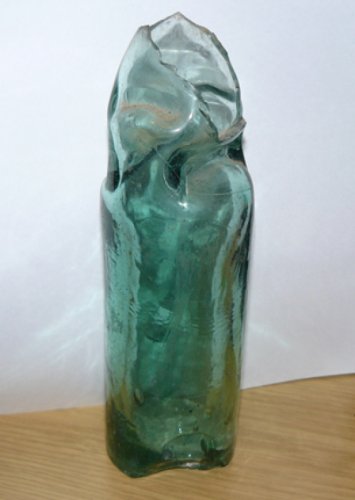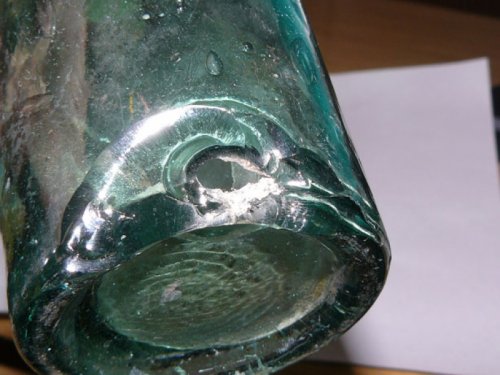I've had it happen a few times, it sucks but it's to be expected if you play with glass your sure to break a few peaces. I've broke a few during cleaning, the dirt hid cracks and fractures, nothing to good though. another time, I had a cardboard box with 5 bottles that had been left in the rain for a few days. I was carrying them to the bottle room when the bottom gave way falling to the cement floor and I lost all but 1 bottle in the box, luckily they were all commons ( I did have one of my local pharmacist bottles in that same box, but set it aside to look up before I took the box away.)
You are using an out of date browser. It may not display this or other websites correctly.
You should upgrade or use an alternative browser.
You should upgrade or use an alternative browser.
Bottle suicide
- Thread starter Wheelah23
- Start date
SAbottles
Well-Known Member
it's the people walking around that bare watching.--Fred.
ORIGINAL: mr.fred
Do you mean they walk around "nude" ?[]
mr.fred
Well-Known Member
ORIGINAL: SAbottles
it's the people walking around that bare watching.--Fred.Sorry teach[8|]----i will write it 50 times![ORIGINAL: mr.fred
Do you mean they walk around "nude" ?[]
][
]
SAbottles
Well-Known Member
That's OK; it's the ones watching the naked bears that worry me  ]
]
mr.fred
Well-Known Member
[sm=lol.gif][sm=lol.gif]ORIGINAL: SAbottles
That's OK; it's the ones watching the naked bears that worry me ![]
SAbottles
Well-Known Member
On the topic of bottles that go "Pow!" ~ on the opposite side of the valley to my house is the site of an early glass factory. I found the largest section of a Codd to come from the site (about two thirds) and had it standing on a window ledge. There must have been a large bubble, because one day I heard a loud "Pow!" sound and found that a plug of glass had been shot out of the side of the bottle.
RED Matthews
Well-Known Member
Hello all: I just wrote four paragraphs explaining why this type of breakage happens. Then when I got done I hit some key I shouldn’t have and lost the dissertation. TSC
In the process of creating the molten glass in a crucible or a tank furnace; the batch materials have to be blended and mixed together as completely as possible. In the early days of glass making, this practice was done on a dirt floor and cleanliness and mixed in pieces of stone or other contaminates were included in the melted mixture. In modern days’ the batch is held in silos and bins and distributed to a furnace feeder, that feeds them into a furnace for melting. It is important even today that the batch mix includes some pieces of shattered glass cullet, to help pull the added batch material down into the melt of blending new glass metal.
Now then; in the period of hand blown bottles,. when the glass is ready to use: ( which requires 24 hours at least in a crucible melt); it is gathered on a blow pipe as a solid gather of the right amount to make the bottle. It is puffed with air which is expanded and shaped into the shape of the parison, needed to make the bottle with even distribution of the hollow glass formed in the final form of the bottle; which is usually controlled by a final mold. This shaping and forming puts lines (technically “cordsâ€) of stress in the glass. These lines can be exacerbated by shoulder shapes, heal tap, thickness differences and there is no known definable location. These lines can sometimes be seen under ultraviolet light exposure.
The answer to these cords is the process of annealing This process is credited to the Egyptians, but I feel it had to be discovered sooner that their involvement. No one knows for sure. In the annealing the temperature of the final glass product has to be heated up in the annealing furnace to about 75 to a hundred twenty five degrees above the final formed temperature, and then slow cooled to room temperature in the furnace. This is needed to relieve the lines of internal stress.
I once had a large ash tray on our coffee table with a large letter M in the bottom of it. It exploded one evening on the table with out even being touched or used. It broke in the area of that thick M glass. I also had a large Advertising Whiskey Bottle that shattered in the shoulder area and the cracked out pieces fell inside. It just happens when the glass is not properly annealed.
So fair warning with your dug glass – exposure to sun and other temperature changes can release the cords of stress in the glass. RED Matthews
In the process of creating the molten glass in a crucible or a tank furnace; the batch materials have to be blended and mixed together as completely as possible. In the early days of glass making, this practice was done on a dirt floor and cleanliness and mixed in pieces of stone or other contaminates were included in the melted mixture. In modern days’ the batch is held in silos and bins and distributed to a furnace feeder, that feeds them into a furnace for melting. It is important even today that the batch mix includes some pieces of shattered glass cullet, to help pull the added batch material down into the melt of blending new glass metal.
Now then; in the period of hand blown bottles,. when the glass is ready to use: ( which requires 24 hours at least in a crucible melt); it is gathered on a blow pipe as a solid gather of the right amount to make the bottle. It is puffed with air which is expanded and shaped into the shape of the parison, needed to make the bottle with even distribution of the hollow glass formed in the final form of the bottle; which is usually controlled by a final mold. This shaping and forming puts lines (technically “cordsâ€) of stress in the glass. These lines can be exacerbated by shoulder shapes, heal tap, thickness differences and there is no known definable location. These lines can sometimes be seen under ultraviolet light exposure.
The answer to these cords is the process of annealing This process is credited to the Egyptians, but I feel it had to be discovered sooner that their involvement. No one knows for sure. In the annealing the temperature of the final glass product has to be heated up in the annealing furnace to about 75 to a hundred twenty five degrees above the final formed temperature, and then slow cooled to room temperature in the furnace. This is needed to relieve the lines of internal stress.
I once had a large ash tray on our coffee table with a large letter M in the bottom of it. It exploded one evening on the table with out even being touched or used. It broke in the area of that thick M glass. I also had a large Advertising Whiskey Bottle that shattered in the shoulder area and the cracked out pieces fell inside. It just happens when the glass is not properly annealed.
So fair warning with your dug glass – exposure to sun and other temperature changes can release the cords of stress in the glass. RED Matthews
SAbottles
Well-Known Member
SAbottles
Well-Known Member
SAbottles
Well-Known Member
Nice explanation, Red. You got that in while I was down in my garage rummaging for the bottle & then photographing it !
Similar threads
- Replies
- 14
- Views
- 4K
- Replies
- 7
- Views
- 467
- Replies
- 0
- Views
- 408
- Replies
- 11
- Views
- 2K
Latest posts
-
-
I need some help with a Orange Crush bottle
- Latest: Step Back In Time
Latest threads
-
-
-
-
-
-
Bayer Aspirin bottle or something else?
- Started by Mlzeigler
- Replies: 1




